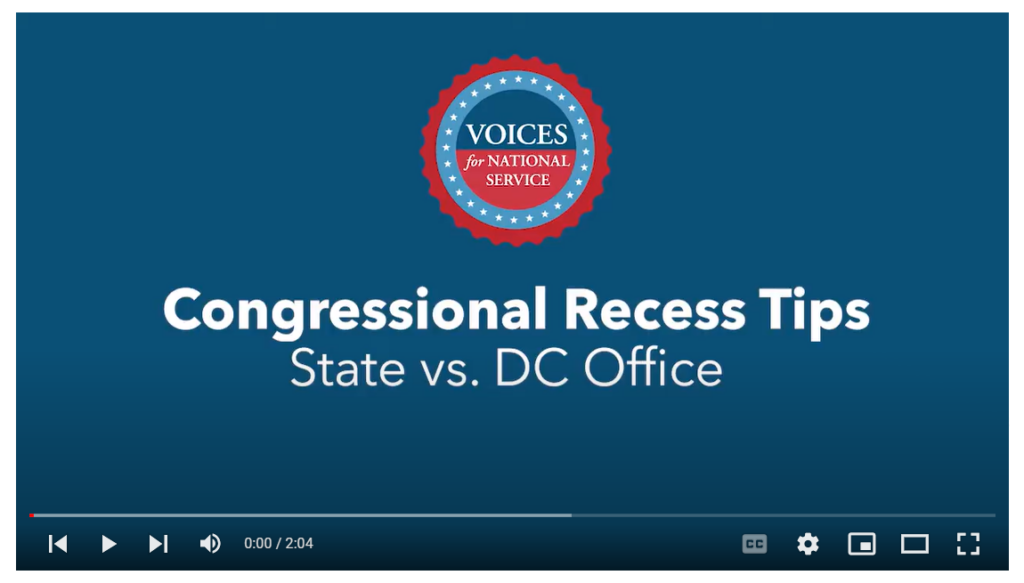Advocate’s Guide to AmeriCorps & Appropriations
Each year, 200,000 AmeriCorps members and AmeriCorps Seniors volunteers address locally-identified needs in rural and urban communities across all 50 states, DC, and the territories. From natural disaster response to combatting food insecurity, and providing services to veterans to helping seniors live independently, AmeriCorps grants and service members currently support over 2,000 local organizations and millions of Americans nationwide.
Despite being a model of efficient and effective government, AmeriCorps programs and agency operations have been significantly disrupted in recent months. The following executive actions have left communities without critical resources:
- Close to $400 million in grants were terminated in mid-April, impacting more than 1,000 nonprofits and 32,000 AmeriCorps members and AmeriCorps Seniors volunteers;
- Nearly 750 AmeriCorps NCCC and FEMA Corps members were demobilized, ending their service with no advance notice;
- Approximately 85% of agency staff were dismissed, disrupting key functions such as program operations, member enrollment and deployment, and grant disbursement; and
- OMB delayed nearly $200 million in FY25 congressionally-appropriated funding, jeopardizing operations of state service commissions and nearly 180 approved AmeriCorps and AmeriCorps Seniors grantees.
While these actions have been challenged in court and reversed at some level, they have significantly disrupted the delivery of services across all 50 states.
Now, President Trump’s Fiscal Year 2026 budget has proposed the complete elimination of AmeriCorps. And the House Appropriations Committee advanced a FY26 Labor-HHS-Education bill that proposes to slash AmeriCorps funding by nearly 50% – eliminating tens of thousands of service positions and stripping communities of critical support in education, disaster response, public health, and more.
We need your help. Urge your lawmakers to protect AmeriCorps.
How Can I Help?
If you believe AmeriCorps makes a difference in your community, we urge you to contact your lawmakers and share how federal funding – and the AmeriCorps members and AmeriCorps Seniors volunteers it supports – is being leveraged in their district/state to solve urgent local needs.
Join us in calling on Congress to protect and invest in AmeriCorps. This webpage is our “Advocate’s Guide to AmeriCorps and Appropriations.” It will be updated with new and refreshed resources on a rolling basis.
If you have any questions or would like to schedule a call to discuss key messages or engagement opportunities, please email Shanelle Oliver, Director of Advocacy & Outreach, at soliver2@cityyear.org.
Fast Action Tools:
Take Action to Save AmeriCorps
It is up to us to convince Congress to protect AmeriCorps funding – and the 200,000 AmeriCorps members and AmeriCorps Seniors volunteers it supports. Together, we can make sure our lawmakers know investing in AmeriCorps isn’t nice, it is essential.
Taking action to Save AmeriCorps is as easy as 1, 2, 3:
1. Contact Your Member of Congress
2. Host a District Site Visit, Meeting, or Event
3. Write a Letter to the Editor or Op-Ed
1. Contact your member of Congress
Email: Use our Contact Congress form to email your Senators and Representatives to ask them to protect AmeriCorps.
Call: Help us flood offices with calls in support of AmeriCorps, using our call script/talking points.
2. Host a District Site Visit, Meeting, or Event
Host a District Site Visit
A site visit to a service location is a key way to demonstrate the essential services your organization provides and the real-life benefits of fully funding AmeriCorps.
Resources:
- Best practices for requesting a service site visit w/ template
- 2025 Congressional Calendar (House & Senate)
Meet with your member(s) of Congress
A meeting with your member of Congress or their senior staff is one of the most valuable ways that you can explain the impact your program is having in the communities they represent and the important role AmeriCorps funding plays in those results. These meetings can either take place in Washington D.C. or the lawmaker’s district/state office.
Resources:
- Best practices for requesting to meet with a member of Congress w/ template
- 2025 Congressional Calendar (House and Senate)
3. Write a Letter to the Editor or Op-Ed
Members of Congress closely monitor constituent interests and concerns via local news outlets. An opinion piece or letter to the editor about AmeriCorps’ local impact is a great way to get their attention and garner public support.
Resources:
Additional Tools and Resources:
No matter how you engage with your lawmakers, it is critical that you emphasize the importance of funding AmeriCorps in all messages.
- General AmeriCorps Messaging: Use these talking points as a basis for how to discuss the value of AmeriCorps with lawmakers.
- FY26 Federal Funding Background: Refer to this one-pager as an overview of the current proposals around federal funding for AmeriCorps.
- Tips for Handling Tough Questions: Prior to connecting with your lawmaker, review our tips for how to respond to more challenging questions.

Advocacy Starts at Home – In 2019, Voices for National Service interviewed Brian McNabb, Senator Bill Cassidy’s State Director (R-LA), to discuss the role of the district office, how to cultivate a relationship with district staff, and tips for leveraging an in-district meeting. There are many benefits to beginning your AmeriCorps advocacy in the Congressperson’s district, away from the chaos and distractions of Washington, D.C. Check out this short video series to make the most of engaging with your member of Congress at home, and building a connection based in your local community that will transfer to the halls of the U.S. Capitol.


